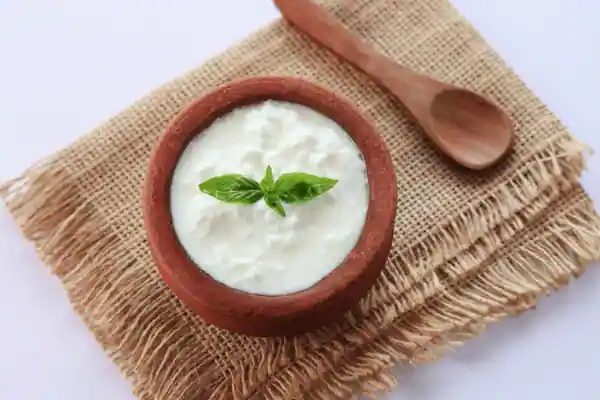
PLANT-BASED NON-DAIRY (VEGAN) CURD
The curd prepared from plant-based milk is nutrient dense and hence should be consumed in limited quantities. It is ideal to consume buttermilk made by adding four to five cups of water to one cup of curd.
DISTINCTION BETWEEN CURD MADE FROM PLANT-BASED MILK AND DAIRY MILK
The very composition of the milk from these two sources is glaringly different. The milk produced by a mammal is meant for its offspring and hence its composition is unique and in accordance with the nutritional requirements of the offspring. It is meant for her offspring alone and none else. On the contrary the milk extracted from plantbased sources too is unique in the sense that its nutrients can be absorbed efficiently by the whole of the human race which consumes it. The curd made from plant-based sources doesn’t set tight like the curd made from animal milk as their composition is different.
For example, the fat present in curd made from coconut milk is heat sensitive and melts even at 200C. Coconut milk curd remains tight in refrigerator but becomes loose at room temperature.However,plant-based curds are a rich source of Vitamin B12 and probiotics. A considerable percentage of population today is suffering from B12 deficiency and is taking solace in supplements. If the whole of the human race turns to plant-based products for all its nutritional needs and uses them judiciously and not greedily almost all the problems (health, environment) being faced today will disappear.
A TIP FROM TRADITIONAL WISDOM BY DR. KHADAR VALI Refrigerator entered Indian homes on a larger scale only five to six decades ago. Then how were we preserving food and curd six decades above? A basket filled with moist sand used to be placed in a cool corner of the kitchen and curd was kept in a clay pot neck deep into it. They ensured that the sand stays moist and cool. Those who have the opportunity to dedicate a corner in your kitchens may adopt this method.
A WORD OF CAUTION
We generally do not boil milk obtained from plant-based sources. We only warm up the milk using hot water bath method.Therefore,utmost hygiene needs to be maintained during the process of extraction of milk, fermentation and preservation to prevent contamination. This curd should be consumed within two days from the day of preparation.
Types of Plant-based and Vegan Curd
Delicious Vegan curds can also be made at home, and we’re listing 4 of them, so you can either choose your most preferred flavor or just make them whenever you’re in the mood for experimenting.
Peanut Rice Curd
This curd generally tastes good in kadhis (curries) and in other dishes such as dahi-aloo, chaas, meethi lassi etc, though you may not enjoy it in sweet dishes. It can be made in 15 mins (excluding the settling time). Listed below are it’s ingredients and the steps to make this vegan curd at home.
Ingredients: 4 cups peanut milk (freshly made), 1/3 cup rice, soaked overnight (7-8 hours) & drained, 2 cups water, 1 teaspoon sugar (optional) and 2 tablespoon curd starter liquid/starter curd
Steps to prepare peanut rice curd
- Grind the soaked rice with 2-3 tablespoons of water in a small mixer jar on the highest setting for a couple of minutes. Add the rest of the water and blend again. Filter through a wet porous cloth to get 2 cups of raw rice milk. Mix with the peanut milk.
- In a deep bottomed kadhai/saucepan, bring the peanut-rice milk to a boil, stirring occasionally. Add sugar, if using. Lower the heat and simmer for 3-4 minutes.
- Let it cool down for some time. Once it is just slightly warm—you should be able to dip a finger comfortably—mix in the starter curd and stir well.
- Keep aside to set for as long as you would for dairy curd according to the climatic conditions in your region. Setting time would vary from 5-7 hours in summer to 10-12 hours in winter.
Melon Seed and Rice Curd
This one of a truly rare category of vegan curds which are completely nut, soy and obviously dairy free. Mentioned below are both the ingredients and the process that are used to make it.
Ingredients: 1 cup melon seeds (maghaz), soaked for 4-5 hours & drained, 1 cup rice (any kind), soaked for 4-5 hours & drained, 6 cups water (900 ml), 1 teaspoon sugar (optional, but recommended) and 2-3 tablespoons starter curd/starter liquid
Steps to prepare melon seed and rice curd
- Grind the soaked melon seeds with one cup water on the mixer’s highest setting until smooth and creamy. Add two more cups of water and blend well. Keep aside.
- Grind the soaked rice with one cup of water on the mixer’s highest setting for a couple of minutes. Add two more cups of water and grind again. Strain this mixture through a wet porous cloth to get raw rice milk.
- Combine the melon seed milk + rice milk in a deep-bottomed kadhai/saucepan. Add sugar, if using. Cook on low-medium heat for 7-8 minutes, stirring frequently until the mixture becomes thick and bubbly (like custard of pouring consistency).
- Let the mixture cool down for several minutes. Once it is just slightly warm—you should be able to dip a finger comfortably—mix in the starter curd/ starter liquid and stir well.
- Keep the culture aside for as long as you would for dairy curd according to the climatic conditions in your region. Setting time would vary from 5-7 hours in summer to 10-12 hours in winter.
Cashew Rice Curd
This thick and delicious and thick curd is great as an occasional treat. It is a bit expensive thanks to the price of cashews and it does take 15 mins to prepare plus additional time for setting and soaking. However, the price and additional time are well worth the taste.
Ingredients: 1 cup broken cashews, soaked for 4-5 hours & drained, 1 cup rice (any kind), soaked for 4-5 hours & drained, 6 cups water (900 ml) and 2-3 tablespoons starter curd/starter liquid
Steps to prepare cashew rice curd
- Grind the soaked cashews with one cup water on the mixer’s highest setting until smooth and creamy. Add two more cups of water and blend well. Keep aside.
- Grind the soaked rice with one cup of water on the mixer’s highest setting for a couple of minutes. Add two more cups of water and grind again. Strain this mixture through a wet porous cloth to get raw rice milk.
- Combine the cashew milk + rice milk in a deep-bottomed kadhai/saucepan. Cook on low-medium heat for 7-8 minutes, stirring frequently until the mixture becomes thick and bubbly (like custard of pouring consistency).
- Let the mixture cool down for several minutes. Once it is just slightly warm—you should be able to dip a finger comfortably—mix in the starter curd/starter liquid and stir well.
- Keep the culture aside for as long as you would for dairy curd according to the climatic conditions in your region. Setting time would vary from 5-7 hours in summer to 10-12 hours in winter.
Coconut Curd
This thick, creamy curd is the best choice for you if you like the taste of…, you guessed it, coconuts.
Ingredients: 4 cups first-extract coconut milk* (600 ml), ½ cup water, 2 heaped tablespoons corn flour and 2-3 tablespoons starter liquid
Steps to prepare coconut curd
- Whisk the corn flour with ½ cup water until smooth. Add to the coconut milk and mix well.
- Cook the coconut milk over medium heat, stirring continuously, for 5-6 minutes until it reaches a thick, custard-like consistency.
- Let it cool until it’s just slightly warm; you should be able to dip a finger comfortably. Mix in the starter liquid and keep aside overnight (6-8 hours).
To make 4 cups of thick (first extract) coconut milk, soak 4 cups of grated fresh mature coconut in 4 cups of hot water for 15-20 minutes. Blend on high speed until thick and creamy. Strain using a fine mesh sieve or a piece of wet cotton cloth. Reserve the milk and use the residual pulp in some other recipe. Alternatively, you can use store-bought coconut milk that comes in tetra packs/cans.
Making Vegan Curd at Home
The process of making curd is rather simple, though it admittedly does contain many steps. However if followed correctly, they do lead to the creation of a curd which tastes truly great.
For the purpose of explaining the process, we’ll be using our own VD curd culture. Curd can be made with some changes in these steps as well, but we recommend sticking to this process, especially
- Take your favourite brand of 1 litre Packaged Soya Milk (We recommend SoGood’s Unsweetened Soya Beverage)
- Heat it up to 60-70°c but do not boil it.
- Cut 1 sachet of Soya Curd Culture and add it to the heated milk. Add some water to remove the residual culture.
- Stir well for 30-40 seconds
- Cover it and place it in a warm place.
- Check after 6-8 Hours and the curd should be set and ready to consume.
Depending on the weather, the curd may take more or less time. For cooler places, you may need to warm the milk mixed with curd culture every 3 hours for the next 10-12 hours. However, please do not boil it!
Store in a freezer and consume within 2-3 days.
We’ll also add a list of off the shelf vegan curd and curd culture options down below for you to choose from.
Goodmylk – Plant-based Curd – Goodmylk’s Peanut Curd is a great vegan alternative to regular dairy curd if you’re alright with the flavour of peanuts. Their curd has no lactose or preservatives and is rich in protein. Their thick and creamy curd is also packed with nutrients and is rich in probiotics and can be used in a variety of foods, right from dips and dressings to curd rice, and curries.
Posh Flavors Vegan Bulgarian Yogurt Starter | Non-GMO | 100% Vegan Pla – Vegan Dukan – Their freeze-dried yogurt culture contains plant-based live cultures, which provides over 1 billion good probiotics beneficial bacterias. Curd made from their culture helps in boosting immunity, and is GMO and gluten free.
